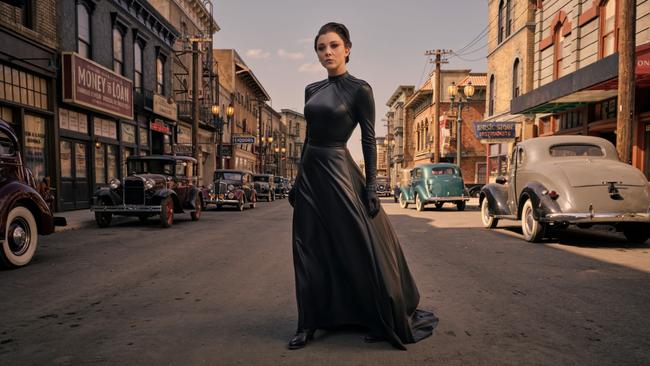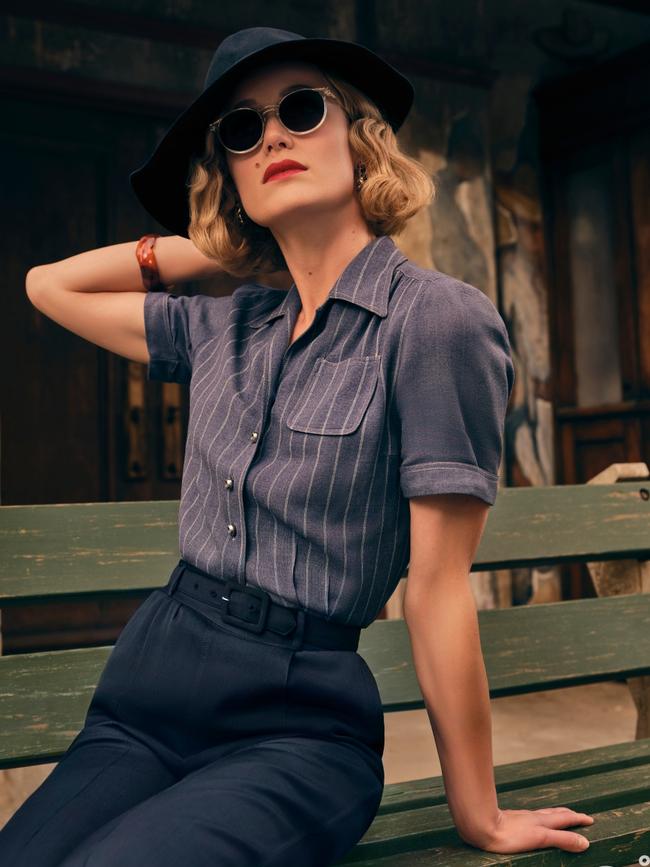Penny Dreadful, city of Angels and demons
This hardboiled detective story, set on the gritty streets of 1930s LA, takes you inside a city of Angels and demons.

Horror movies, piled high with mystery, suspense, gore, terror and shock, are in great demand at the moment on our television screens, allowing us to safely transmute the dread we feel as the unseen killer lurks outside our doors in real life and every stranger is a threat. So John Logan’s new horror TV series, Penny Dreadful: City of Angels, comes just at the right moment as we juggle the anxiety, caution and insecurity, finding some relief in TV that captures the universal fear of death and the unknown.
Logan is one of the most interesting creators and writers in the game, a sophisticated talent equally at home with stage, film and, in recent years, TV. He’s a three-time Academy Award-nominated screenwriter whose movies include Skyfall, Sweeney Todd, The Aviator, Hugo, Gladiator, and The Last Samurai. His new series is a so-called “spiritual descendant” of his first Penny Dreadful series and is again executive-produced by Sam Mendes.
The director is the in-demand Paco Cabezas, who worked with Logan on the first Penny Dreadful. Cabezas reveals a distinct feel for the graphic nature of horror and is adroit at trafficking in the cinematic sorts of things that cause disquiet, having directed episodes of The Alienist, The Strain and The Walking Dead. He also wrote and directed Spanish horror film The Appeared and wrote the screenplay for horror-comedy film Sexykiller.
In the first series of gothic horrors that premiered six years ago and ran for three successful seasons, Logan reimagined characters such as Mina Harker from Bram Stoker’s Dracula, Victor Frankenstein from Mary Shelley’s Frankenstein and Dorian Gray from Oscar Wilde’s The Picture of Dorian Gray as though they really existed, in an epic tale of a heroic quest to save a lost soul. Logan set his show, produced in wonderfully extravagant style, in the Dickensian London of 1891. From the start he established a beguiling tone in which the preposterous and the absurd were treated with gravitas and solemnity within the superbly realised backdrop of Victorian England.
The series wittily borrowed its title from the cheap but popular weekly publications of the 19th century; penny dreadful was an unofficial literary genre describing cheap serial fiction published in weekly eight- or 16-page instalments. Also known as penny awfuls, penny horribles and penny bloods, their rapturous readers were reeled in by stories of poisoning, strangling, kidnapping and hair’s-breadth escapes, racy yarns of boy detectives, body snatchers unearthing corpses at midnight and vampires having their way with defenceless virgins.
Logan’s new series — set in 1938, 40 years after the original show — provides just as much escapism, adventure, romance and certainly gore, wrapped up in some highly intelligent, beautifully produced pulpy, speculative fiction.
Penny Dreadful: City of Angels is a drama that speaks to the history of race, ethnicity and power in early 20th-century Los Angeles, and in particular the devastation brought to immigrant communities by city planners and developers through their obsession with freeways. Attracted to LA, once known as El Pueblo de la Reina de los Angeles (The Town of the Queen of Angels), by the promise of paradise, they found economic displacement, racial resentment and increasing xenophobia.
READ MORE: WATCH: Sarah Blasko in the Isolation Room | Killing Eve ‘The most addictive show on television’
Logan provides a visionary journey across a place Raymond Chandler described as “a city no worse than others, a city rich and vigorous and full of pride, a city lost and beaten and full of emptiness”. Questioning the dislocations, the dominant homily of progress, Logan’s story is pungent, lushly stylish and certainly timely.
“The most important thing to remember for me about this show is, while it’s set in 1938, it’s about 2020,” Logan told reporters at the Television Critics Association winter press tour in January. “Looking over the world landscape now, I am struck by parallels, particularly the rise of extremist political hatred, a sort of racist demagoguery that is taken for granted, by the pernicious influence of foreign power in our electoral process and particularly by the marginalisation and victimisation of an ethnic community. And as the son of immigrants myself, this is a story I wanted to tell.” (Logan comes from an Irish background, his parents from Belfast.)
But, while his central narrative — again there are many strands and different character arcs — is wonderfully imagined, there is a deal of research behind the issues it raises, especially when it comes to the involvement of the Nazis in pre-war Los Angeles, a central thread.
“The biggest revelation I had researching this, the years of researching this, was the extent of the Third Reich infiltration of Los Angeles in the late 30s,” Logan told Paste magazine. “Because New York was closed to them because mayor (Fiorello) LaGuardia was half Jewish, so he wasn’t letting Germans in. There was a real iron wall around New York, but California, particularly Los Angeles, was like the Wild West, and the aircraft factories were centred here, the armament factories, the film studios, so it became really rife for sabotage and for clandestine activity of the Third Reich.”

To contain all this he gives us a kind of hard-boiled detective narrative in a magic-realist setting, a violent fairy story, set against the emergence of mythologised city that represents a combination of corruption and glamour, profoundly decadent and characterised by violence and cynicism.
It begins with fire and fury as we’re introduced to Magda, played by Game of Thrones’ Natalie Dormer, some kind of supernatural agent of pandemonium, a shape-changer determined, she tells us in a long monologue to begin the story, to find the final spark to allow the world to burst. She’s speaking across a country road to her sister, Lorenza Izzo’s Santa Muerte, the gaudily dressed Angel of Holy Death, who mythologically ferries the dead to heaven, death embraced not as the end of all things but as a move towards another state of being.
It’s a wonderful scene, replete with Mexican religious symbology, directed with baroque style by Cabezas, ending as Magda strides across the fields of early LA in search of souls, fire consuming anyone in her way. As she creates more disorder as the plot unfolds, the figure of Muerte reflects the reality the underprivileged characters in Logan’s story find themselves prey to — a reality of violence, distress and marginalisation. We’re quickly at the centre of a murder investigation involving a new detective, Daniel Zovatto’s suave Tiago Vega, proudly the first Mexican in the position, and the subject of humiliation and racial abuse from his Anglo colleagues. But from the start, while betrayed and wounded by the world of white men, he’s determined to create his own code of ethics, a self-appointed preserver of decency.
He’s supported by his older partner, Nathan Lane’s grizzled Lewis Michener, a veteran officer in the Los Angeles Police Department who becomes Vega’s mentor. Both performances are splendid; Zovatto gravely assured and Lane, obviously enjoying himself enormously as Michener, another outsider like his protege, subtly big-hearted and empathetic. (Lane in a recent press gig described the series rather drolly as “Raymond Chandler meets Rod Serling”.)
They are summoned to the mutilated bodies of four wealthy white people displayed beneath part of a new freeway, their faces ritualistically made up. A sign painted in blood nearby reads, “You take our heart; we take yours”. The murders are linked to Dia de Muertos, the Mexican Day of the Dead celebrations, and the investigation begins against the backdrop of the planned construction of LA’s Arroyo Seco Parkway, which threatens to displace Vega’s family and neighbourhood.
The other narrative strand is the Third Reich infiltration of LA at the time, centred on the figure of Peter Craft, played by Rory Kinnear, a successful German paediatrician and head of the German-American Bund, an association he hopes will keep the US isolated from the growing threat of war in Europe. Other Nazis lurk at the edges of this story arc, including an aristocratic and mysterious German architect, a friend of Hitler, it seems, with ostentatious plans for the future of Los Angeles, with unsettling connections to City Hall. (LA was well disposed for Nazi messaging. It was a durable centre outside the American south for the Ku Klux Klan, with large gatherings held throughout the 1920s; in the 30s black musicians referred to LA’s suburbs as “Little Texas” or “Little Mississippi”.)
The first episode cinematically lays out the context and the outlines of Logan’s plot — this is a series with flair and enormous style. The production design is stunning; this LA is a city of looming monoliths, endless alleyways and outlying precincts teeming with illegal activity, and those massive concrete freeways under construction, their horizontal lines forming visual prisons entrapping Logan’s characters.
Cabezas’s direction cleverly uses sweeping and often towering wide shots, allowing us into the full scene, letting us absorb all the details at once, giving context for what’s about to happen and often editing within the shot, moving the camera on vast cranes. He uses the kind of deep focus once identified only with major Hollywood movies, considered pointless on small, low-resolution TV screens for decades, a place where the close-up ruled.
Logan’s new show is so right for the moment — a smart, exuberantly ghoulish guilty pleasure.
Penny Dreadful: City of Angels, Sunday, streaming on Stan.


To join the conversation, please log in. Don't have an account? Register
Join the conversation, you are commenting as Logout